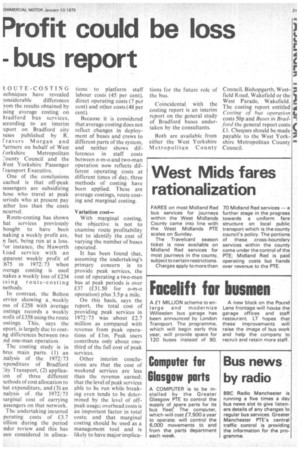Profit could be loss •
Page 23

If you've noticed an error in this article please click here to report it so we can fix it.
bus report
ZOUTE-COSTING echniques have revealed
:onsiderable differences 'rom the results obtained by ming average costing on 3radford bus services, iccording to an interim .eport on Bradford city )uses published by R. ravers M organ and 'artners on behalf of West
(orkshire Metropolitan 7,ounty Council and the West Yorkshire Passenger fransport Executive.
One of the conclusions cached is that off-peak )assengers are subsidizing hose who travel at peak )eriods who at present pay ather less than the costs ncurred.
Route-costing has shown hat services previously hought to have been naking a weekly profit are, n fact, being run at a loss. or instance, the Haworth toad service with an tpparent weekly profit of :675 in 1972/73 when tverage costing is used nakes a weekly loss of £234 'sing route-costing nethods.
In contrast, the Bolton ervice showing a weekly oss of £258 with average .ostings records a weekly wofit of E.358 using the route .ostings. This, says the eport, is largely due to costrig differences between two .nd one-man operation.
The costing study is in hree main parts. (1) an .nalysis of the 1972/73 xpenditure of Bradford 7ity Transport. (2) applicaLon of three different lethods of cost allocation to hat expenditure, and (3) an nalysis of. the 1972/73 -iarginal cost of carrying assengers on that network.
The undertaking incurred perating costs of £3.7 fillion during the period nder review and this has een considered in alloca
tions to platform staff labour costs (45 per cent), direct operating costs (7 per cent) and other costs (48 per cent).
Because it is considered that average costing does not reflect changes in deployment of buses and crews to different parts of the system, and neither shows differences in staff costs between o-m-o and two-man operation now reflects different operating costs at different times of day, three methods of costing have been applied. These are average costings, route costing and marginal costing.
Variation cost—
With marginal costing, the objective is not to examine route profitability but to identify the cost of varying the number of buses operated.
It has been found that, assuming the undertaking's primary concern is to provide peak services, the cost of operating a two-man bus at peak periods is over £37 (£31.50 for o-m-o operation) plus 3.5p a mile.
On this basis, says the report, the total cost of providing peak services in 1972 / 73 was about £2.7 million as compared with revenue from peak operations of E 1 m. Peak users contribute only about onethird of the full cost of peak services.
Other interim conclusions are that the cost of weekend services are less than the revenue earned; that the level of peak services able to be run while breaking even tends to be determined by the level of offpeak usage; overhead costs is an important factor in total costs; and that marginal costing should be used as a management tool and is likely to have major implica
tions for the future role of the bus.
Coincidental with the costing report is an interim report on the general study of Bradford buses undertaken by the consultants.
Both are available from either the West Yorkshire Metropolitan County
ty. Council, Bishopgarth, West; field Road, Wakefield or the West Parade, Wakefield. The costing report entitled A Costing of hus operation ti costs 50p and Buses in Bradn ford the general report costs
£ I. Cheques should be made 5. payable to the West York0 shire Metropolitan County "m Council.




































































































